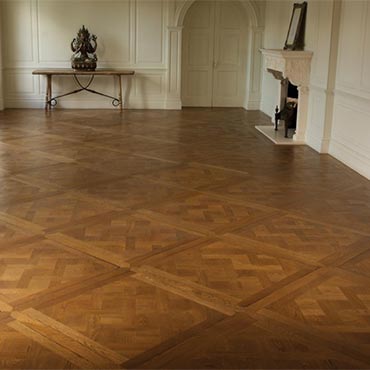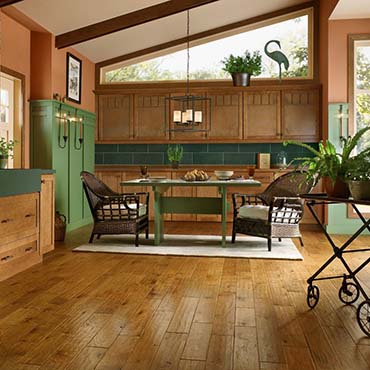Parquet Flooring

Parquet Flooring: Reviving Timeless Elegance in Modern Design
In the realm of interior design, the choice of flooring plays a pivotal role in defining the ambiance and character of a space. Among the myriad of flooring options, Parquet Flooring stands out as a symbol of sophistication and timeless elegance, seamlessly blending into the narrative of modern interior design. This article delves into the significance of Parquet Flooring, exploring its types, species, and versatility, while offering insights for interior designers, decorators, and design consultants on leveraging its potential to enhance various spaces.
Understanding Parquet Flooring: Definition and Types
Parquet Flooring, derived from the French word 'parqueterie', refers to a mosaic of wood pieces used for decorative flooring. Characterized by its geometric patterns, this flooring style originated in the 16th century as an alternative to
marble flooring. It comprises small wooden blocks or strips arranged in distinct, repeating patterns. The most common types include herringbone, chevron, basketweave, and Versailles patterns.
Types and Species of Wood
The aesthetic appeal of Parquet Flooring is partly due to the diverse species of wood used, each offering unique hues and grain patterns. Oak, walnut, cherry, and maple are popular choices, providing durability and a distinct color palette. Exotic woods like mahogany and teak are also used for more luxurious installations.
Versatility and Durability
One of Parquet Flooring's strengths is its versatility. It can be adapted to various interior styles, from classic to contemporary. Its geometric patterns add depth and texture to spaces, making them visually appealing. In terms of durability, high-quality Parquet Flooring withstands the test of time, enduring daily wear and tear while maintaining its charm.
Sustainability and Environmental Impact
The shift towards eco-friendly design has elevated the status of Parquet Flooring. Many manufacturers now use sustainably sourced wood and eco-friendly adhesives and finishes, making Parquet Flooring an environmentally responsible choice. Its longevity also implies less frequent replacements, reducing environmental impact.
Enhancing Interior Spaces with Parquet Flooring
Parquet Flooring adds a layer of sophistication to any room. The natural warmth of wood and the intricacy of patterns create a focal point, enriching the overall aesthetic. It works exceptionally well in large, open spaces where the designs can be fully appreciated. However, it is versatile enough for smaller rooms, adding depth and the illusion of space.
Tips for Interior Design Professionals
When selecting Parquet Flooring, consider the following:
- Room Usage: High-traffic areas may require harder wood species.
- Lighting: The wood's color can dramatically change under different lighting.
- Room Size and Ceiling Height: Larger patterns suit spacious rooms with high ceilings, while smaller patterns work better in compact spaces.
- Overall Decor Theme: Ensure the Parquet pattern complements the room's decor and furniture.
Features and Benefits
Parquet Flooring offers numerous benefits:
- Aesthetic Appeal: Unique patterns and natural wood tones add elegance.
- Durability: Properly maintained, it can last for decades.
- Value Addition: It can increase property value.
- Warmth and Comfort: Wood is naturally warm and comfortable underfoot.
Recent Trends and Innovations
The world of Parquet Flooring is ever-evolving, with recent trends including:
- Mixed-Material Parquet: Combining wood with other materials like metal or stone for a contemporary twist.
- Gray and Whitewashed Woods: Offering a modern, minimalist look.
- Larger Planks and Tiles: For a more dramatic, bold statement.
- Eco-Friendly Materials: Bamboo and reclaimed wood are becoming popular.
Conclusion
Parquet Flooring is more than just a flooring choice; it's a design statement. Its versatility, sustainability, and timeless appeal make it a preferred option for interior designers and decorators looking to infuse spaces with character and elegance. By understanding its nuances and staying abreast of trends, design professionals can effectively utilize Parquet Flooring to create spaces that are both beautiful and functional.
Disclaimer: The information provided in this article is for general informational purposes only. While we strive to ensure the accuracy and reliability of the information presented, we make no warranties, express or implied, about the completeness, accuracy, reliability, suitability, or availability with respect to the content. Any reliance you place on such information is strictly at your own risk. We recommend consulting with professionals for specific advice tailored to your project’s needs, particularly regarding building codes, regulations, and product specifications.
Under no circumstances shall we be liable for any loss or damage, including without limitation, indirect or consequential loss or damage, arising from the use of, or reliance on, the information provided in this article.





